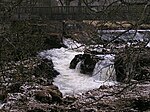Cawood Castle
Castles in North YorkshireCawoodEpiscopal palaces of archbishops of YorkGrade I listed buildings in North YorkshireLandmark Trust properties in England ... and 1 more
Use British English from April 2017

Cawood Castle is a grade I listed building in Cawood, a village in North Yorkshire, England. The surviving fifteenth-century structures formed part of a fortified medieval palace belonging to the Archbishops of York, which was dismantled in the aftermath of the English Civil War.
Excerpt from the Wikipedia article Cawood Castle (License: CC BY-SA 3.0, Authors, Images).Cawood Castle
Sherburn Street,
Geographical coordinates (GPS) Address Nearby Places Show on map
Geographical coordinates (GPS)
| Latitude | Longitude |
|---|---|
| N 53.8315 ° | E -1.1309 ° |
Address
Sherburn Street
Sherburn Street
YO8 3SR
England, United Kingdom
Open on Google Maps










